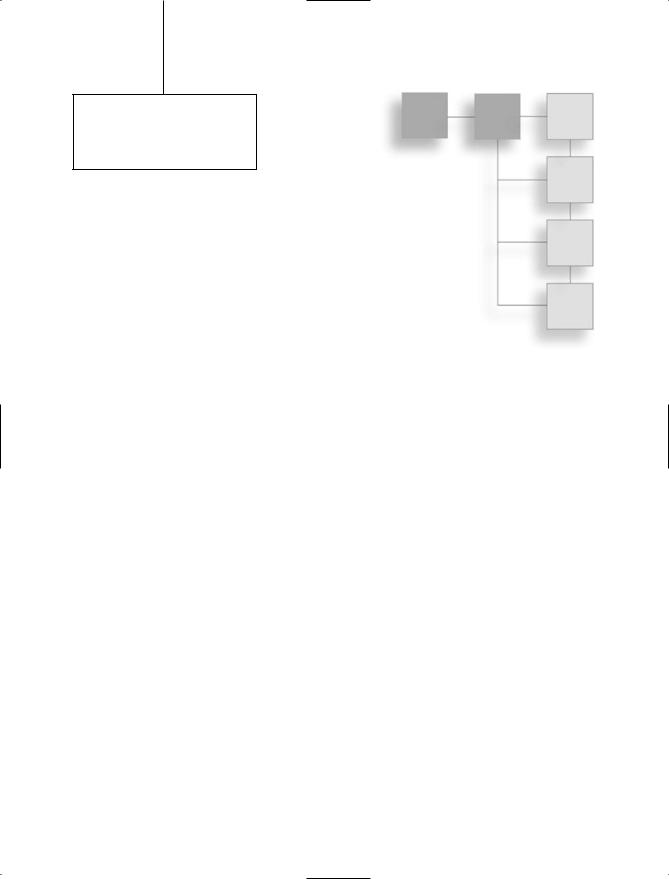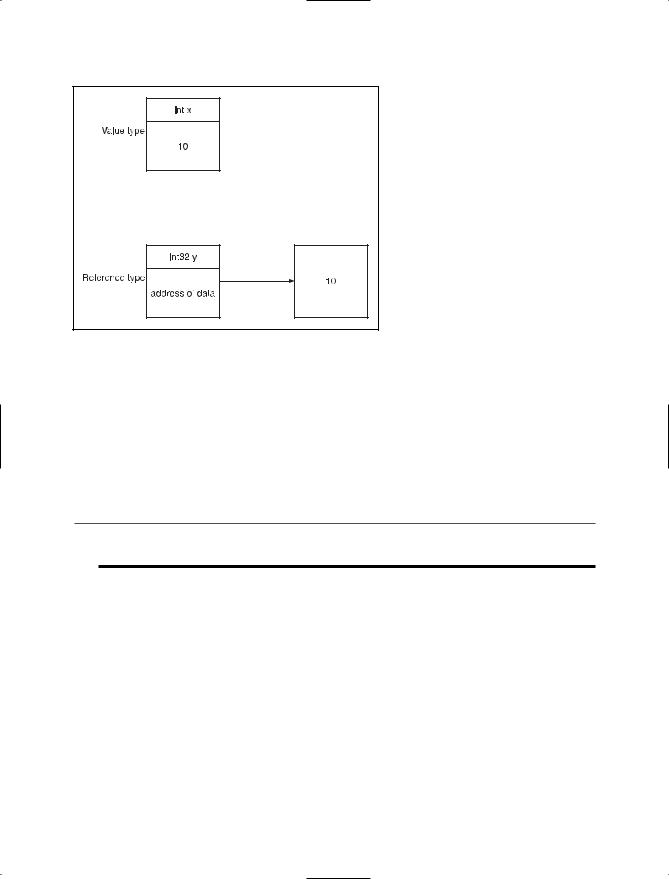
Beginning CSharp Game Programming (2005) [eng]
.pdf
30 Chapter 2 The Basics
if( x == 3 )
continue; |
// jump back up to top, skip anything below |
FunctionB();
}
Pretend that FunctionA and FunctionB actually exist for a moment. This loop will make x go through every number from 0 to 9. On every single iteration, FunctionA will be executed, but when x is 3, the code will skip FunctionB() and jump right up to the top of the loop again.
Scoping
The term scope, when dealing with a computer program, refers to the place in a program where a variable is valid. For example, say you have this code in a program:
class ScopeDemo
{
static void Main( string[] args )
{// bracket A
int x = 10;
}// bracket B
static void blah()
{
// x = 20; <—- YOU CAN’T DO THIS!
}
}
The variable x is said to have a scope between brackets A and B. If you tried referencing x outside of those brackets, the C# compiler will give you a strange look and ask you what the hell you’re talking about.
Seems simple enough, doesn’t it? Here’s another example:
static void Main(string[] args)
{
if( 2 == 2 )
{// bracket A
int y;
}// bracket B
// y = 10; <—- YOU CAN’T DO THIS!
}
The if block in this code will always execute because 2 is, obviously, always equal to 2; but that’s beside the point. Inside of brackets A and B, a new variable, y, is created, and then the if block ends. But y only has a scope in between those two brackets, meaning that

Summary 31
nothing outside of the brackets can access it; so if you try using y outside of the if block, the computer will barf error messages all over you because it has no idea what y actually is.
There’s still one more example I’d like to show you:
static void Main(string[] args)
{
for( int x = 0; x < 10; x++ )
{
// do something here
}
// x = 10; <—- YOU CAN’T DO THIS!
}
In this final example, you’ve created a new variable x inside the for statement, and you can access x anywhere inside the parentheses or the for block, but nowhere outside of it.
Summary
Computer languages are very complex, and no one can ever fully understand an entire language anymore—they’re just far too complex nowadays. Luckily, you won’t need many of the features in a language, so you don’t have to be a versed expert in the language in order to use it—that’s what reference manuals are for.
This chapter is enough to get you started on making some simple C# programs, but you really can’t do anything really complex yet. But that’s okay; you’re only two chapters into the book!
This chapter has shown you how to create your very first C# program and compile it, and has introduced you to the very basic concepts of the language, such as the basic data types, mathematical operators, conditional statements, and looping statements. In the next chapter you’ll go on to even more advanced topics.
What You Learned
The main concepts that you should have picked up from this chapter are:
How to compile and run a C# program.
Every program has a main class that defines an entry point, where program execution starts.
There are many built-in numeric data types in C#.
Short-circuit evaluation can be used to speed up your programs, but may introduce unforeseen flaws.
Constants make your programs easier to read.

32 Chapter 2 The Basics
Typecasts are strict in C# when compared to C/C++, because you might accidentally lose data if you’re not paying close enough attention.
Scoping allows you to manage your variables in an efficient manner.
Review Questions
These review questions test your knowledge of the important concepts explained in this chapter. The answers can be found in Appendix A.
2.1.Every C# program requires at least one main static class. (True/False)
2.2.Booleans are only 1 bit in size. (True/False)
2.3.Unsigned integers can hold numbers up to around 4 billion. (True/False)
2.4.Floating point numbers hold exact representations of numbers. (True/False)
2.5.Why can’t you use variables before they have been assigned a value?
2.6.Why do constants make your programs easier to read?
2.7.Is the following code valid?
int x = 10;
float y = 20;
x = y;
(Yes/No)
2.8. What is the value of x after this code is done?
int x = 10;
if( x == 10 )
x = 20;
2.9.Assume that c is 0. What are the values of the variables after this code is done, and why?
int w = 0, x = 0, y = 0, z = 0; switch( c )
{
case 0:
w = 10; case 1:
x = 10; case 2:
y = 10; break;
case 3:
z = 10; break;
}

Summary 33
2.10.Now assume that c is 2 and the code from Question 2.9 is run again. What are the values of the variables w, x, y, and z?
2.11.Does the computer compare the value of x and 10 in this example?
int x = 10, y = 20;
if( y == 20 && x == 10 )
x = 20;
2.12. Does the computer compare the value of x and 10 in this example?
int x = 10, y = 20;
if( y == 20 || x == 10 )
x = 20;
2.13. When this code is completed, what is the value of x?
int x = 0;
while( x < 10 )
x++;
2.14. For each loop, does the value of x increase before FunctionA executes or after it executes?
for( int x = 0; x < 10; x++ )
{
FunctionA();
}
2.15.Rewrite the code in Question 2.14 using a while loop instead.
2.16.How many times is FunctionA executed?
int x = 0; do
{
FunctionA(); } while( x == 1 );
2.17. What is the value of x after the following code is done?
int x = 0;
for( int y = 0; y < 10; y += 2 )
{
if( y == 4 ) break;
x++;
}
2.18. What is the value of x after the following code is done?
int x = 0;
for( int y = 0; y < 10; y += 2 )

34 Chapter 2 The Basics
{
if( y == 4 )
continue;
x++;
}
2.19. Is this code valid? (Assume that FunctionA exists.)
for( int y = 0; y < 10; y++ )
{
FunctionA();
}
y = 0;
On Your Own
Play around with the looping structures to find out what they do exactly. Sometimes they can be a little bit difficult to pick up for an absolute beginner, and it’s very important that you learn exactly how they operate before you start making serious code.

chapter 3
A Brief Introduction to Classes
By now, you should feel comfortable enough with C# to pound out a very simple program. You really don’t know how to use any of the more powerful features of C# yet, though, so this chapter will to show you how. I’m not going to go over everything in the language—I’d need to write a much larger book to do that, and I still wouldn’t have any room to get into the game programming stuff. Right now, I’m mostly going to go over things that will be important to game programming.
In this chapter, you will learn:
The primary differences between value types and reference types.
How garbage collection works and makes your programs safer.
The basics of structures and classes.
The differences between structures and classes.
How functions, parameters, and return values work.
How constructors and destructors work.
How inheritance and data hiding works.
How static members work.
How accessors and properties make your programs safer.
How enumerated types make your programs easier to read.
35

36 Chapter 3 A Brief Introduction to Classes
Values versus References
There are different ways for a compiler to talk about data, and C# has two different ways to do so. All datatypes in C# fall into one of two categories:
Value types
Reference types
I’ll explain each of these different kinds of types in the following sections.
Value Types
A value type is typically a small piece of data that the system spends very little time managing. You have already used value types in Chapter 2 with all of the built-in numeric data types. Everything listed in Table 2.1—such as ints, floats, and so on—is a value type.
n o t e
Value types are created on the system stack. You don’t necessarily need to know what that is, but if you’re interested, I strongly urge you to research it on your own. This topic goes beyond the scope of this book, so I don’t have enough room to explain it here, but it greatly helps you understand exactly how computers work, which will in turn make your programs faster and more efficient.
Value types are fairly simple and straightforward to use, as you can see in this code:
int x = 10, y = 20; |
|
|||
x |
= |
y; |
// value of |
y is copied into x |
y |
= |
10; |
// y is set |
to 10 |
Along with the built-in data types, structures are value types as well, which I explore in much more detail later in this chapter.
Reference Types
Reference types are completely different from value types. Classes, unlike structures, are always reference types. Reference types, rather than storing the data directly, store an address inside of them, and that address points to the actual data in the computer somewhere. Check out Figure 3.1.
Declaring a Reference Type
One of the biggest differences between values and references lies in the way you declare them. A reference type must be created using the new keyword (pretend we have a class named Foo):
Foo x = new Foo();

Values versus References |
37 |
Figure 3.1 Value types are stored directly, whereas reference types store an address pointing to the actual data.
That may look like a lot of work at first, but you’ll get used to it. Basically, the code is performing two tasks. It is:
1.creating a new reference type named x, and
2.creating a new Foo object on the heap and making x point to it.
n o t e
The heap is another part of the computer that stores memory. I don’t have enough room to explain it here; this is something else you should research on your own if you’re interested.
Of course, you don’t have to do that all at once. You could easily split it up like this:
Foo x;
x = new Foo();
It’s up to you.
Playing with References
Now it’s time to play around with references, which is something you haven’t done before. Unfortunately for you, references don’t exactly work the same way as value types, and this can be kind of confusing at first.

38 Chapter 3 A Brief Introduction to Classes
This is where references tend to get a bit tricky. You absolutely must remember at all times that you are using references, or else you will end up with programs that don’t act the way you want them to act. For example, try to guess what this code does:
Foo x = new Foo();
Foo y = new Foo();
y = x;
// perform some operation that changes y here
You’d think that after this code executes, x would be in its original state and y would be changed, right? Wrong! They’re both changed. Bear with me—it’s a little difficult to see at first, but it makes sense. A diagram may help; see Figure 3.2.
Figure 3.2 Assigning x to y makes y point to x’s data, and doesn’t actually copy the value as you would expect.
Basically, the line that really messes everything up is the following:
y = x;
What does that actually accomplish? You probably wanted to copy the data from x into y, but that didn’t happen. Instead, as they are both reference types, the computer makes y point to the same data that x is pointing to. So x and y are now pointing to the same data in memory, and performing any operation on y will do the same to x.
n o t e
If you really wanted to copy a reference type into a new reference type rather than just making two references point to the same data, you need to use a built-in C# function to perform a clone of the class. You can see this done with the GameObject class in Chapter 10.

Basics of Structures and Classes |
39 |
Garbage Collection
In the example shown in Figure 3.2, you may have noticed that y was given some memory, which it then ignored once it was assigned to x. What happens to that memory that y was pointing to?
In older languages, like C, the memory would be lost forever. You would be creating what is called a dangling pointer (pointers are like references); the computer knows that the memory is being used, but your program forgot where it was, and you’ll never be able to reclaim that memory until you shut down the program.
C# solves this problem using garbage collection. Every time you create a new piece of data in C#, the .NET runtime keeps track of how many times your program is pointing at that data, and if that number ever goes down to 0, then the garbage collector will detect it and release that memory for something else to use.
It is impossible to create memory leaks in C#.
n o t e
Okay, it is possible to create memory leaks in C#. But I’m not going to show you how. Nya Nya. You don’t want to know anyway, believe me.
null
There’s a special value that you can use with reference types; it’s called null. The null value essentially means “nothing.” If you set a reference to null, then you’re telling the computer that the reference is pointing to nothing at all. Older languages used the value 0 to denote this, but null is more readable.
Basics of Structures and Classes
In the olden days of computer programming, programming languages were quite simple, and you could create only a limited number of variables. This, obviously, made programs very limited and quite ugly, to boot. For example, you would be creating programs like the following in an older language:
int SpaceshipArmor;
int SpaceshipPower;
int SpaceshipFuel;
int EnemyArmor;
int EnemyPower;
int EnemyFuel;
As you can imagine, this gets to be a tangled mess rather quickly, and makes it very difficult to manage your code.
